Towards Optimising the Derivation of Phenological Phases of Different Crop Types over Germany Using Satellite Image Time Series
Abstract
1. Introduction
2. Study Area and Data
2.1. Study Area
2.2. Phenological In-Situ Data
2.3. Agricultural Parcel Data
2.4. Cloud Processing Platform and Satellite Data
3. Methods
3.1. High-Quality Crop-Specific NDVI Time-Series Reconstruction
3.1.1. Extracting Upper Envelope
3.1.2. Smoothing the NDVI Upper Envelope
3.2. Phenological Analysis
3.2.1. Identifying Crop Phenological Cycles
- We defined the time periods during which we expect that a specific crop should generally grow by analyzing the crop calendars in Germany for the previous years (Table 1).
- All the local maxima were identified from the reconstructed time series corresponding to the crop window selected in step 1.
- An ensemble of hyperparameters was used to filter out the erroneous maxima. The first one uses a specific threshold of 0.4 to remove the lower values because several studies suggested that the maximum values for crops generally exceed 0.4, as suggested in other studies [52]. We also used a search window of 30 days in this study. If multiple peaks can still be identified, we rely on the peak’s prominence, which is a popular cue that indirectly quantifies how much a peak stands out from its surroundings.
- Once the local maxima of our crop had been extracted, a similar approach was adopted to find out if the left and right minima could then be found for this corresponding phenological cycle.
- Lastly, we employed the selected local maxima along with the left and right minima, and the area they span, to define the crop’s phenological cycle.
3.2.2. Calculation of Phenological Metrics
3.2.3. Optimal Parameterisation of Phenological Thresholds
3.2.4. Assessment of Pheno-Phases Detection Using Optimal Thresholds
4. Results
4.1. Sample Results of Reconstructed Temporal Profiles and Identified Phenological Cycles
4.2. Optimisation of Phenological Phases
4.3. Validation of Phenological Estimates
5. Discussion
5.1. Time Series Reconstruction
5.2. Phenological Estimates and Optimisation
5.3. Limitations and Way Forward
6. Conclusions
Author Contributions
Funding
Data Availability Statement
Acknowledgments
Conflicts of Interest
Correction Statement
References
- Lieth, H. Purposes of a Phenology Book; Springer: Berlin/Heidelberg, Germany, 1974; pp. 3–19. [Google Scholar] [CrossRef]
- Möller, M.; Gerstmann, H.; Gao, F.; Dahms, T.C.; Förster, M. Coupling of phenological information and simulated vegetation index time series: Limitations and potentials for the assessment and monitoring of soil erosion risk. Catena 2017, 150, 192–205. [Google Scholar] [CrossRef]
- Strassemeyer, J.; Daehmlow, D.; Dominic, A.; Lorenz, S.; Golla, B. SYNOPS-WEB, an online tool for environmental risk assessment to evaluate pesticide strategies on field level. Crop Prot. 2017, 97, 28–44. [Google Scholar] [CrossRef]
- Möller, M.; Doms, J.; Gerstmann, H.; Feike, T. A framework for standardized calculation of weather indices in Germany. Theor. Appl. Climatol. 2019, 136, 377–390. [Google Scholar] [CrossRef]
- Abdi, A.M.; Carrié, R.; Sidemo-Holm, W.; Cai, Z.; Boke-Olén, N.; Smith, H.G.; Eklundh, L.; Ekroos, J. Biodiversity decline with increasing crop productivity in agricultural fields revealed by satellite remote sensing. Ecol. Indic. 2021, 130, 108098. [Google Scholar] [CrossRef]
- Bucheli, J.; Dalhaus, T.; Finger, R. Temperature effects on crop yields in heat index insurance. Food Policy 2022, 107, 102214. [Google Scholar] [CrossRef]
- Marrec, R.; Brusse, T.; Caro, G. Biodiversity-friendly agricultural landscapes—Integrating farming practices and spatiotemporal dynamics. Trends Ecol. Evol. 2022, 37, 731–733. [Google Scholar] [CrossRef] [PubMed]
- Bucheli, J.; Conrad, N.; Wimmer, S.; Dalhaus, T.; Finger, R. Weather insurance in European crop and horticulture production. Clim. Risk Manag. 2023, 41, 100525. [Google Scholar] [CrossRef]
- Riedesel, L.; Möller, M.; Horney, P.; Golla, B.; Piepho, H.P.; Kautz, T.; Feike, T. Timing and intensity of heat and drought stress determine wheat yield losses in Germany. PLoS ONE 2023, 18, e0288202. [Google Scholar] [CrossRef]
- Kaspar, F.; Zimmermann, K.; Polte-Rudolf, C. An overview of the phenological observation network and the phenological database of Germany’s national meteorological service (Deutscher Wetterdienst). Adv. Sci. Res. 2014, 11, 93–99. [Google Scholar] [CrossRef]
- Gao, F.; Zhang, X. Mapping crop phenology in near real-time using satellite remote sensing: Challenges and opportunities. J. Remote Sens. 2021, 2021, 1–14. [Google Scholar] [CrossRef]
- Song, Y.; Wang, J.; Yu, Q.; Huang, J. Using MODIS LAI data to monitor spatio-temporal changes of winter wheat phenology in response to climate warming. Remote Sens. 2020, 12, 786. [Google Scholar] [CrossRef]
- De Beurs, K.M.; Henebry, G.M. Land surface phenology, climatic variation, and institutional change: Analyzing agricultural land cover change in Kazakhstan. Remote Sens. Environ. 2004, 89, 497–509. [Google Scholar] [CrossRef]
- Tucker, C.J. Red and photographic infrared linear combinations for monitoring vegetation. Remote Sens. Environ. 1979, 8, 127–150. [Google Scholar] [CrossRef]
- Zeng, L.; Wardlow, B.D.; Xiang, D.; Hu, S.; Li, D. A review of vegetation phenological metrics extraction using time-series, multispectral satellite data. Remote Sens. Environ. 2020, 237, 111511. [Google Scholar] [CrossRef]
- Misra, G.; Cawkwell, F.; Wingler, A. Status of phenological research using Sentinel-2 data: A review. Remote Sens. 2020, 12, 2760. [Google Scholar] [CrossRef]
- Goward, S.N.; Tucker, C.J.; Dye, D.G. North American vegetation patterns observed with the NOAA-7 advanced very high resolution radiometer. Vegetatio 1985, 64, 3–14. [Google Scholar] [CrossRef]
- Jonsson, P.; Eklundh, L. Seasonality extraction by function fitting to time-series of satellite sensor data. IEEE Trans. Geosci. Remote Sens. 2002, 40, 1824–1832. [Google Scholar] [CrossRef]
- Zhang, X.; Friedl, M.A.; Schaaf, C.B.; Strahler, A.H.; Hodges, J.C.; Gao, F.; Reed, B.C.; Huete, A. Monitoring vegetation phenology using MODIS. Remote Sens. Environ. 2003, 84, 471–475. [Google Scholar] [CrossRef]
- Liu, Z.; Wu, C.; Liu, Y.; Wang, X.; Fang, B.; Yuan, W.; Ge, Q. Spring green-up date derived from GIMMS3g and SPOT-VGT NDVI of winter wheat cropland in the North China Plain. ISPRS J. Photogramm. Remote Sens. 2017, 130, 81–91. [Google Scholar] [CrossRef]
- Melaas, E.K.; Sulla-Menashe, D.; Gray, J.M.; Black, T.A.; Morin, T.H.; Richardson, A.D.; Friedl, M.A. Multisite analysis of land surface phenology in North American temperate and boreal deciduous forests from Landsat. Remote Sens. Environ. 2016, 186, 452–464. [Google Scholar] [CrossRef]
- Bolton, D.K.; Gray, J.M.; Melaas, E.K.; Moon, M.; Eklundh, L.; Friedl, M.A. Continental-scale land surface phenology from harmonized Landsat 8 and Sentinel-2 imagery. Remote Sens. Environ. 2020, 240, 111685. [Google Scholar] [CrossRef]
- Graf, L.V.; Merz, Q.N.; Walter, A.; Aasen, H. Insights from field phenotyping improve satellite remote sensing based in-season estimation of winter wheat growth and phenology. Remote Sens. Environ. 2023, 299, 113860. [Google Scholar] [CrossRef]
- Whitcraft, A.K.; Vermote, E.F.; Becker-Reshef, I.; Justice, C.O. Cloud cover throughout the agricultural growing season: Impacts on passive optical earth observations. Remote Sens. Environ. 2015, 156, 438–447. [Google Scholar] [CrossRef]
- Eklundh, L.; Jönsson, P. TIMESAT 3.1 Software Manual; Lund University: Lund, Sweden, 2012; pp. 1–82. [Google Scholar]
- Holben, B.N. Characteristics of maximum-value composite images from temporal AVHRR data. Int. J. Remote Sens. 1986, 7, 1417–1434. [Google Scholar] [CrossRef]
- Chen, J.; Jönsson, P.; Tamura, M.; Gu, Z.; Matsushita, B.; Eklundh, L. A simple method for reconstructing a high-quality NDVI time-series data set based on the Savitzky–Golay filter. Remote Sens. Environ. 2004, 91, 332–344. [Google Scholar] [CrossRef]
- Savitzky, A.; Golay, M.J. Smoothing and differentiation of data by simplified least squares procedures. Anal. Chem. 1964, 36, 1627–1639. [Google Scholar] [CrossRef]
- Viovy, N.; Arino, O.; Belward, A. The Best Index Slope Extraction (BISE): A method for reducing noise in NDVI time-series. Int. J. Remote Sens. 1992, 13, 1585–1590. [Google Scholar] [CrossRef]
- Beck, P.S.; Atzberger, C.; Høgda, K.A.; Johansen, B.; Skidmore, A.K. Improved monitoring of vegetation dynamics at very high latitudes: A new method using MODIS NDVI. Remote Sens. Environ. 2006, 100, 321–334. [Google Scholar] [CrossRef]
- Yang, G.; Shen, H.; Zhang, L.; He, Z.; Li, X. A moving weighted harmonic analysis method for reconstructing high-quality SPOT VEGETATION NDVI time-series data. IEEE Trans. Geosci. Remote Sens. 2015, 53, 6008–6021. [Google Scholar] [CrossRef]
- Cihlar, J. Identification of contaminated pixels in AVHRR composite images for studies of land biosphere. Remote Sens. Environ. 1996, 56, 149–163. [Google Scholar] [CrossRef]
- Eilers, P.C. A Perfect Smoother. Anal. Chem. 2003, 75, 3299–3304. [Google Scholar] [CrossRef]
- Gray, J.; Sulla-Menashe, D.; Friedl, M.A. User Guide to Collection 6 Modis Land Cover Dynamics (mcd12q2) Product; NASA EOSDIS Land Processes DAAC: Missoula, MT, USA, 2019; Volume 6, pp. 1–8. Available online: https://lpdaac.usgs.gov/documents/1417/MCD12Q2_User_Guide_V61.pdf (accessed on 1 July 2023).
- Meroni, M.; d’Andrimont, R.; Vrieling, A.; Fasbender, D.; Lemoine, G.; Rembold, F.; Seguini, L.; Verhegghen, A. Comparing land surface phenology of major European crops as derived from SAR and multispectral data of Sentinel-1 and-2. Remote Sens. Environ. 2021, 253, 112232. [Google Scholar] [CrossRef] [PubMed]
- Huang, X.; Liu, J.; Zhu, W.; Atzberger, C.; Liu, Q. The optimal threshold and vegetation index time series for retrieving crop phenology based on a modified dynamic threshold method. Remote Sens. 2019, 11, 2725. [Google Scholar] [CrossRef]
- White, M.A.; Thornton, P.E.; Running, S.W. A continental phenology model for monitoring vegetation responses to interannual climatic variability. Glob. Biogeochem. Cycles 1997, 11, 217–234. [Google Scholar] [CrossRef]
- Xu, X.; Conrad, C.; Doktor, D. Optimising phenological metrics extraction for different crop types in Germany using the moderate resolution imaging spectrometer (MODIS). Remote Sens. 2017, 9, 254. [Google Scholar] [CrossRef]
- Gao, F.; Anderson, M.C.; Zhang, X.; Yang, Z.; Alfieri, J.G.; Kustas, W.P.; Mueller, R.; Johnson, D.M.; Prueger, J.H. Toward mapping crop progress at field scales through fusion of Landsat and MODIS imagery. Remote Sens. Environ. 2017, 188, 9–25. [Google Scholar] [CrossRef]
- Tian, F.; Cai, Z.; Jin, H.; Hufkens, K.; Scheifinger, H.; Tagesson, T.; Smets, B.; Van Hoolst, R.; Bonte, K.; Ivits, E.; et al. Calibrating vegetation phenology from Sentinel-2 using eddy covariance, PhenoCam, and PEP725 networks across Europe. Remote Sens. Environ. 2021, 260, 112456. [Google Scholar] [CrossRef]
- Neue Anforderungen im europäischen Naturschutz: Das Schutzgebietssystem Natura 2000 und die FFH-Richtlinie der EU. Nat. Landsch. 1994, 69, 395–406.
- Statistisches Bundesamt (Destatis) 2022 Land-und Forstwirtschaft, Fischerei: Bodenfläche nach Art der tatsäChlichen Nutzung. Available online: https://www.destatis.de/DE/Themen/Branchen-Unternehmen/Landwirtschaft-Forstwirtschaft-Fischerei/Flaechennutzung/Publikationen/Downloads-Flaechennutzung/bodenflaechennutzung-2030510217005.html (accessed on 1 July 2023).
- Kottek, M.; Grieser, J.; Beck, C.; Rudolf, B.; Rubel, F. World map of the Köppen-Geiger climate classification updated. Meteorol. Z. 2006, 15, 259–263. [Google Scholar] [CrossRef]
- Diers, M.; Weigel, R.; Leuschner, C. Both climate sensitivity and growth trend of European beech decrease in the North German Lowlands, while Scots pine still thrives, despite growing sensitivity. Trees 2023, 37, 523–543. [Google Scholar] [CrossRef]
- Meier, U.; Bleiholder, H.; Buhr, L.; Feller, C.; Hack, H.; Heß, M.; Lancashire, P.D.; Schnock, U.; Stauß, R.; Van Den Boom, T.; et al. The BBCH system to coding the phenological growth stages of plants–history and publications. J. Kult. 2009, 61, 41–52. [Google Scholar]
- Gerstmann, H.; Doktor, D.; Gläßer, C.; Möller, M. PHASE: A geostatistical model for the Kriging-based spatial prediction of crop phenology using public phenological and climatological observations. Comput. Electron. Agric. 2016, 127, 726–738. [Google Scholar] [CrossRef]
- Grahmann, K.; Reckling, M.; Hernandez-Ochoa, I.; Donat, M.; Bellingrath-Kimura, S.; Ewert, F. Co-designing a landscape experiment to investigate diversified cropping systems. Agric. Syst. 2024, 217, 103950. [Google Scholar] [CrossRef]
- Benz, U.; Banovsky, I.; Cesarz, A.; Schmidt, M. CODE-DE Portal Handbook, Version 2.0. 2020. Available online: https://code-de.org/en/ (accessed on 15 October 2021).
- ESA. SENTINEL-2 User Handbook. Standard Document, Issue 1 Rev 2. 2015. Available online: https://sentinel.esa.int/documents/247904/685211/Sentinel-2_User_Handbook (accessed on 1 December 2022).
- Main-Knorn, M.; Pflug, B.; Louis, J.; Debaecker, V.; Müller-Wilm, U.; Gascon, F. Sen2Cor for sentinel-2. In Proceedings of the Image and Signal Processing for Remote Sensing XXIII, Warsaw, Poland, 4 October 2017; pp. 37–48. [Google Scholar] [CrossRef]
- Liu, X.; Ji, L.; Zhang, C.; Liu, Y. A method for reconstructing NDVI time-series based on envelope detection and the Savitzky-Golay filter. Int. J. Digit. Earth 2022, 15, 553–584. [Google Scholar] [CrossRef]
- Sakamoto, T.; Yokozawa, M.; Toritani, H.; Shibayama, M.; Ishitsuka, N.; Ohno, H. A crop phenology detection method using time-series MODIS data. Remote Sens. Environ. 2005, 96, 366–374. [Google Scholar] [CrossRef]
- Akiba, T.; Sano, S.; Yanase, T.; Ohta, T.; Koyama, M. Optuna: A next-generation hyperparameter optimization framework. In Proceedings of the 25th ACM SIGKDD International Conference on Knowledge Discovery & Data Mining, Anchorage, AK, USA, 4–8 August 2019; pp. 2623–2631. [Google Scholar] [CrossRef]
- Hoque, A. Variability of Wheat Phenology from Sentinel-1 and-2 Time Series: A Case Study for Brandenburg, Germany. Master’s Thesis, University of Twente, Enschede, The Netherlands, 2022. [Google Scholar]
- Ye, Y.; Zhang, X.; Shen, Y.; Wang, J.; Crimmins, T.; Scheifinger, H. An optimal method for validating satellite-derived land surface phenology using in-situ observations from national phenology networks. ISPRS J. Photogramm. Remote Sens. 2022, 194, 74–90. [Google Scholar] [CrossRef]
- Lobert, F.; Löw, J.; Schwieder, M.; Gocht, A.; Schlund, M.; Hostert, P.; Erasmi, S. A deep learning approach for deriving winter wheat phenology from optical and SAR time series at field level. Remote Sens. Environ. 2023, 298, 113800. [Google Scholar] [CrossRef]
- Thas, O. Comparing Distributions; Springer Series in Statistics; Springer: New York, NY, USA; London, UK, 2010. [Google Scholar]
- Möller, M.; Koschitzki, T.; Hartmann, K.J.; Jahn, R. Plausibility test of conceptual soil maps using relief parameters. CATENA 2012, 88, 57–67. [Google Scholar] [CrossRef]
- Rahman, M.S.; Di, L.; Shrestha, R.; Eugene, G.Y.; Lin, L.; Kang, L.; Deng, M. Comparison of selected noise reduction techniques for MODIS daily NDVI: An empirical analysis on corn and soybean. In Proceedings of the 2016 Fifth International Conference on Agro-Geoinformatics (Agro-Geoinformatics), Tianjin, China, 18–20 July 2016; IEEE: Piscataway, NJ, USA, 2016; pp. 1–5. [Google Scholar] [CrossRef]
- Li, S.; Xu, L.; Jing, Y.; Yin, H.; Li, X.; Guan, X. High-quality vegetation index product generation: A review of NDVI time series reconstruction techniques. Int. J. Appl. Earth Obs. Geoinf. 2021, 105, 102640. [Google Scholar] [CrossRef]
- Atkinson, P.M.; Jeganathan, C.; Dash, J.; Atzberger, C. Inter-comparison of four models for smoothing satellite sensor time-series data to estimate vegetation phenology. Remote Sens. Environ. 2012, 123, 400–417. [Google Scholar] [CrossRef]
- Wang, S.; Chen, J.; Shen, M.; Shi, T.; Liu, L.; Zhang, L.; Dong, Q.; Wang, C. Characterizing spatiotemporal patterns of winter wheat phenology from 1981 to 2016 in North China by improving phenology estimation. Remote Sens. 2022, 14, 4930. [Google Scholar] [CrossRef]
- Bastidas, A.; Setiyono, T.; Dobermann, A.; Cassman, K.G.; Elmore, R.W.; Graef, G.L.; Specht, J.E. Soybean sowing date: The vegetative, reproductive, and agronomic impacts. Crop Sci. 2008, 48, 727–740. [Google Scholar] [CrossRef]
- Sakamoto, T.; Gitelson, A.A.; Arkebauer, T.J. MODIS-based corn grain yield estimation model incorporating crop phenology information. Remote Sens. Environ. 2013, 131, 215–231. [Google Scholar] [CrossRef]
- Sullivan, B.L.; Wood, C.L.; Iliff, M.J.; Bonney, R.E.; Fink, D.; Kelling, S. eBird: A citizen-based bird observation network in the biological sciences. Biol. Conserv. 2009, 142, 2282–2292. [Google Scholar] [CrossRef]
- Siebert, S.; Ewert, F. Spatio-temporal patterns of phenological development in Germany in relation to temperature and day length. Agric. For. Meteorol. 2012, 152, 44–57. [Google Scholar] [CrossRef]
- Möller, M.; Boutarfa, L.; Strassemeyer, J. PhenoWin–An R Shiny application for visualization and extraction of phenological windows in Germany. Comput. Electron. Agric. 2020, 175, 105534. [Google Scholar] [CrossRef]
- Harfenmeister, K.; Itzerott, S.; Weltzien, C.; Spengler, D. Detecting phenological development of winter wheat and winter barley using time series of sentinel-1 and sentinel-2. Remote Sens. 2021, 13, 5036. [Google Scholar] [CrossRef]
- Griffiths, P.; Nendel, C.; Hostert, P. Intra-annual reflectance composites from Sentinel-2 and Landsat for national-scale crop and land cover mapping. Remote Sens. Environ. 2019, 220, 135–151. [Google Scholar] [CrossRef]
- Htitiou, A.; Boudhar, A.; Benabdelouahab, T. Deep learning-based spatiotemporal fusion approach for producing high-resolution NDVI time-series datasets. Can. J. Remote Sens. 2021, 47, 182–197. [Google Scholar] [CrossRef]
- Filgueiras, R.; Mantovani, E.C.; Althoff, D.; Fernandes Filho, E.I.; Cunha, F.F.d. Crop NDVI monitoring based on sentinel 1. Remote Sens. 2019, 11, 1441. [Google Scholar] [CrossRef]

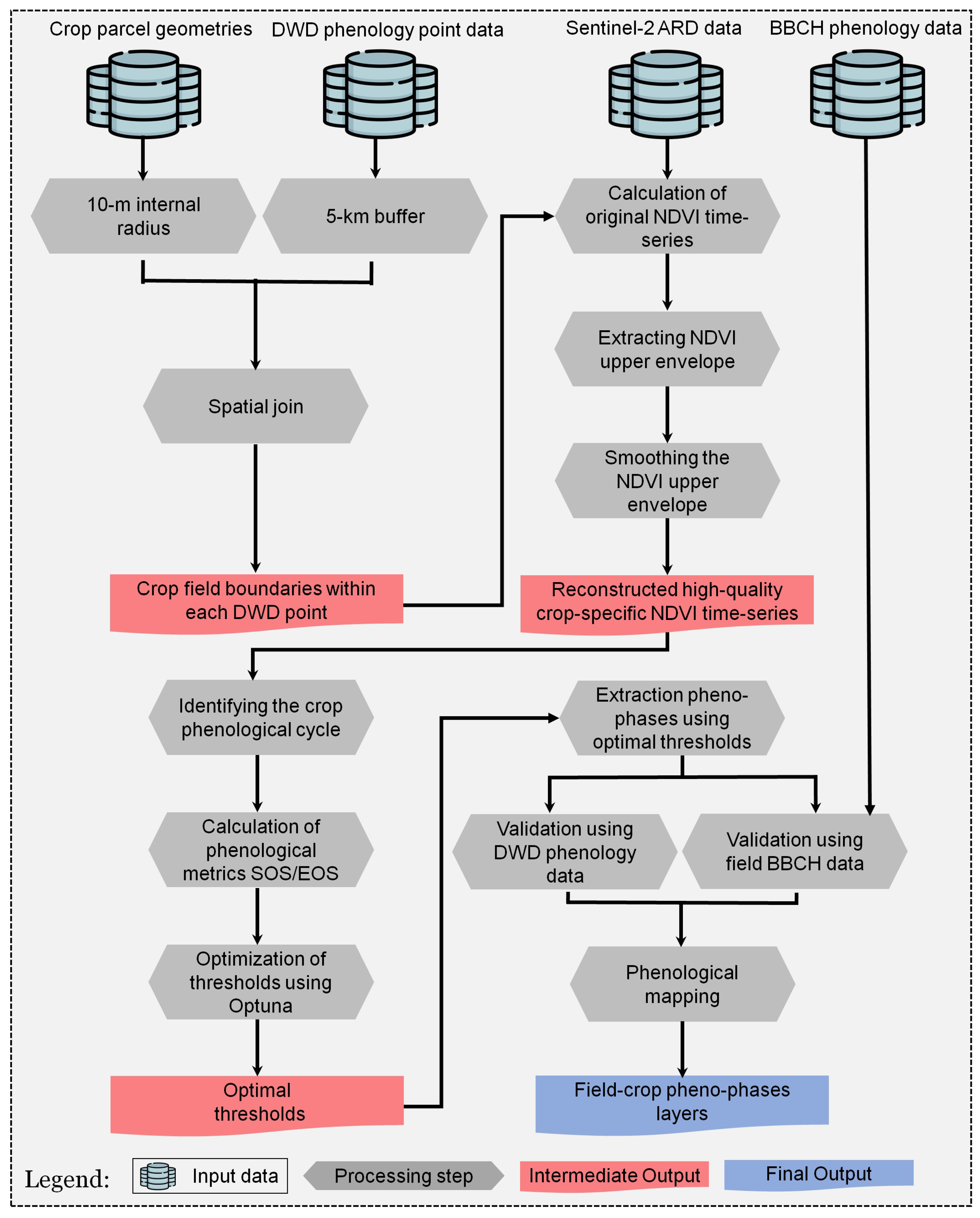
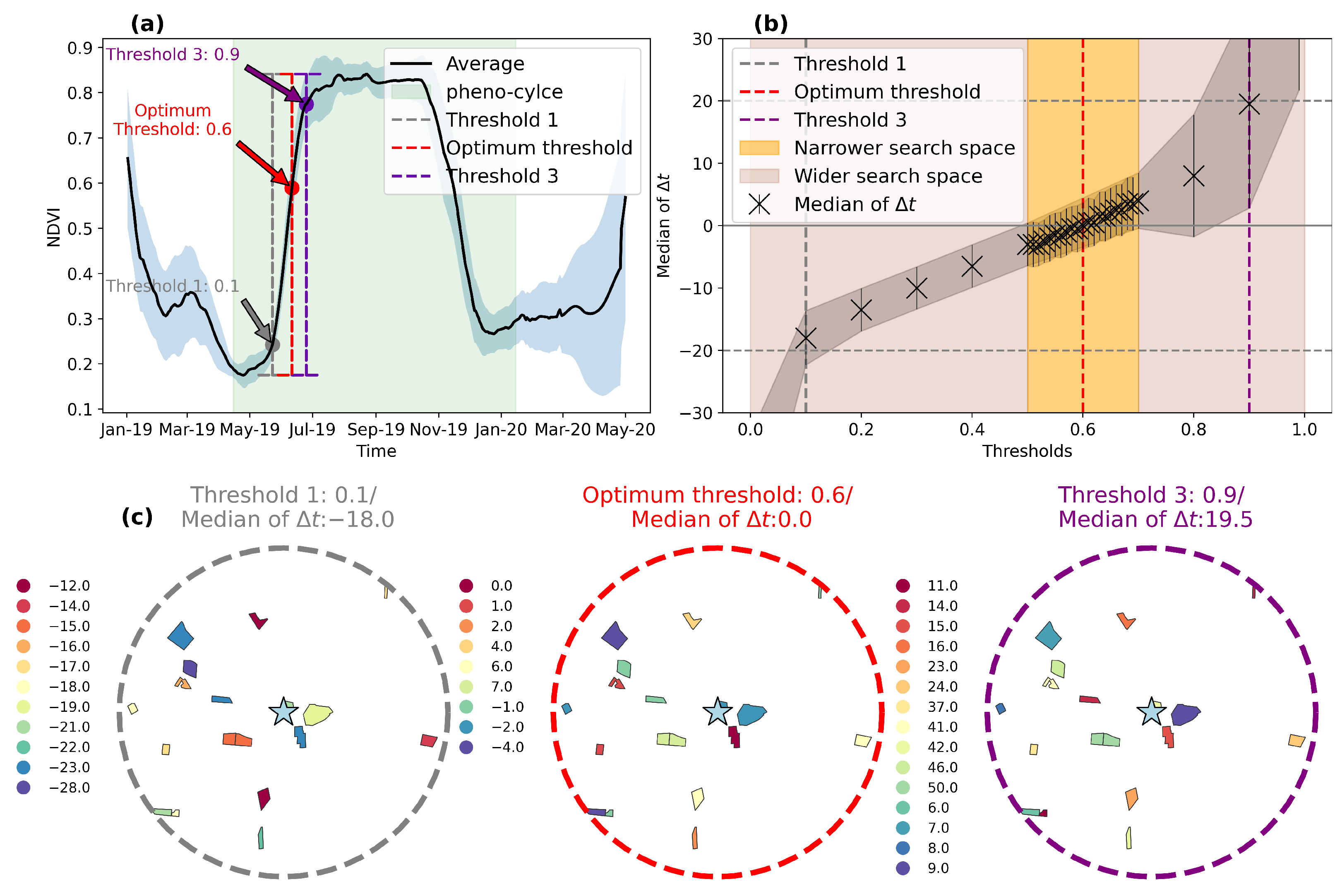
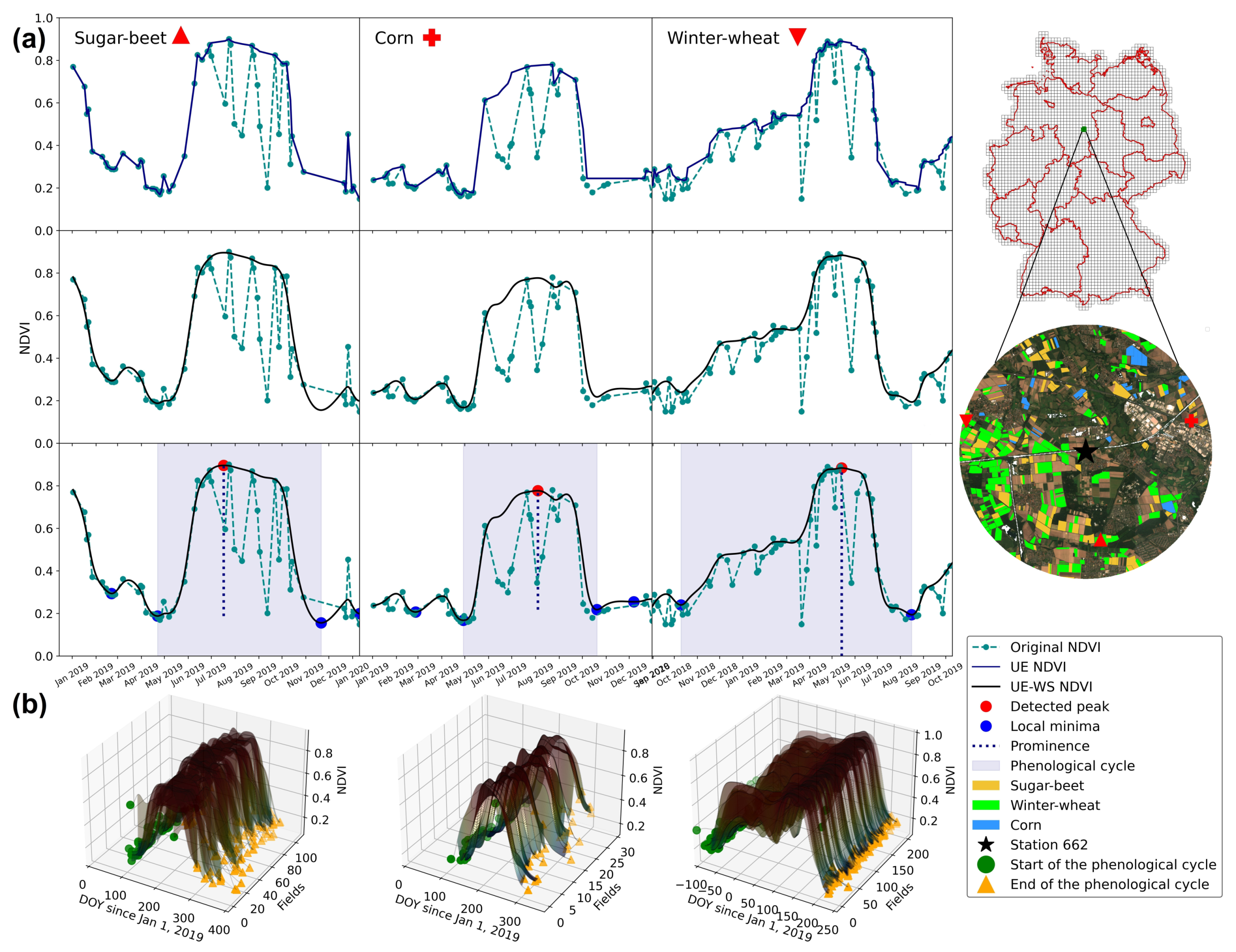

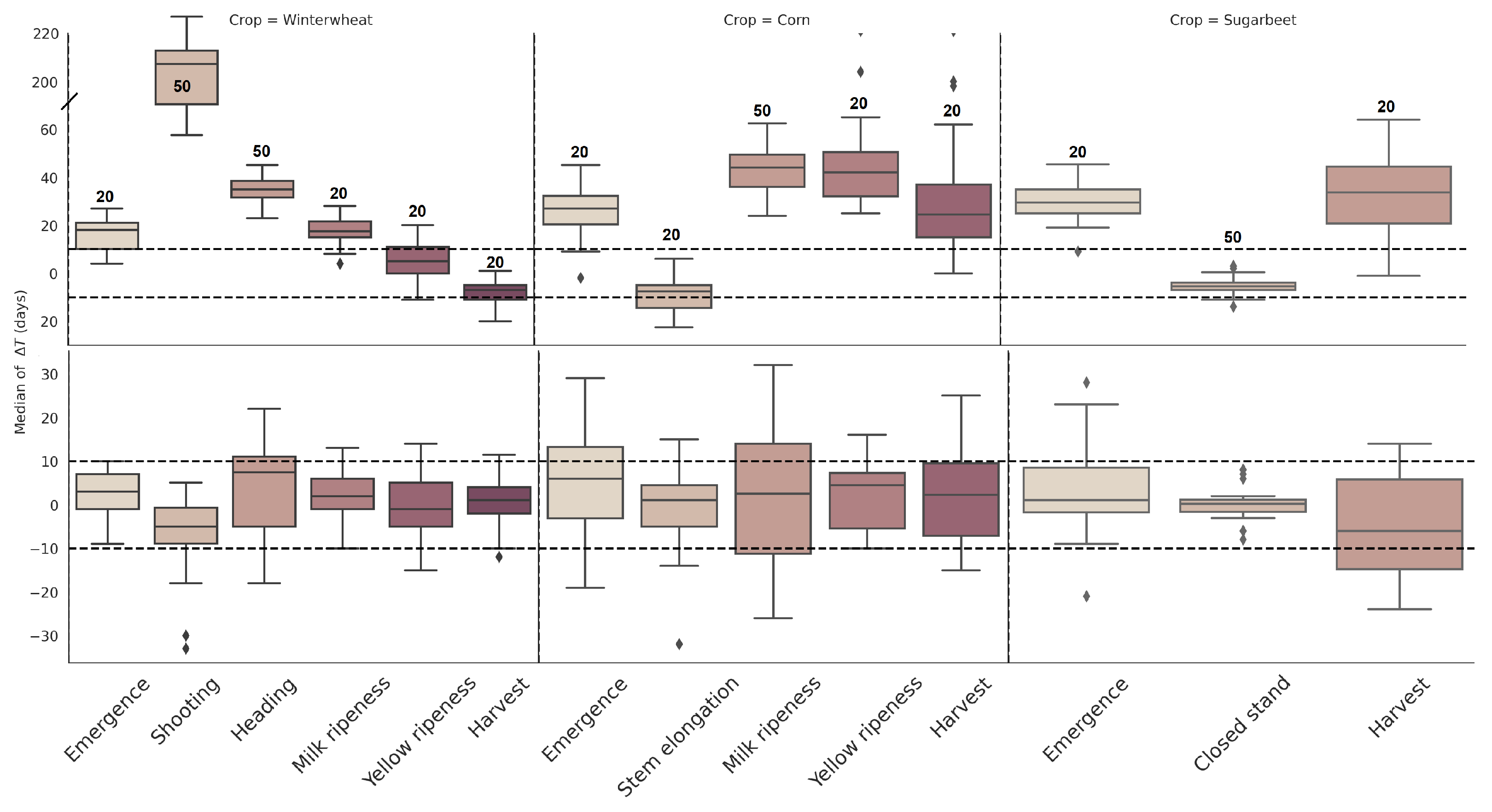
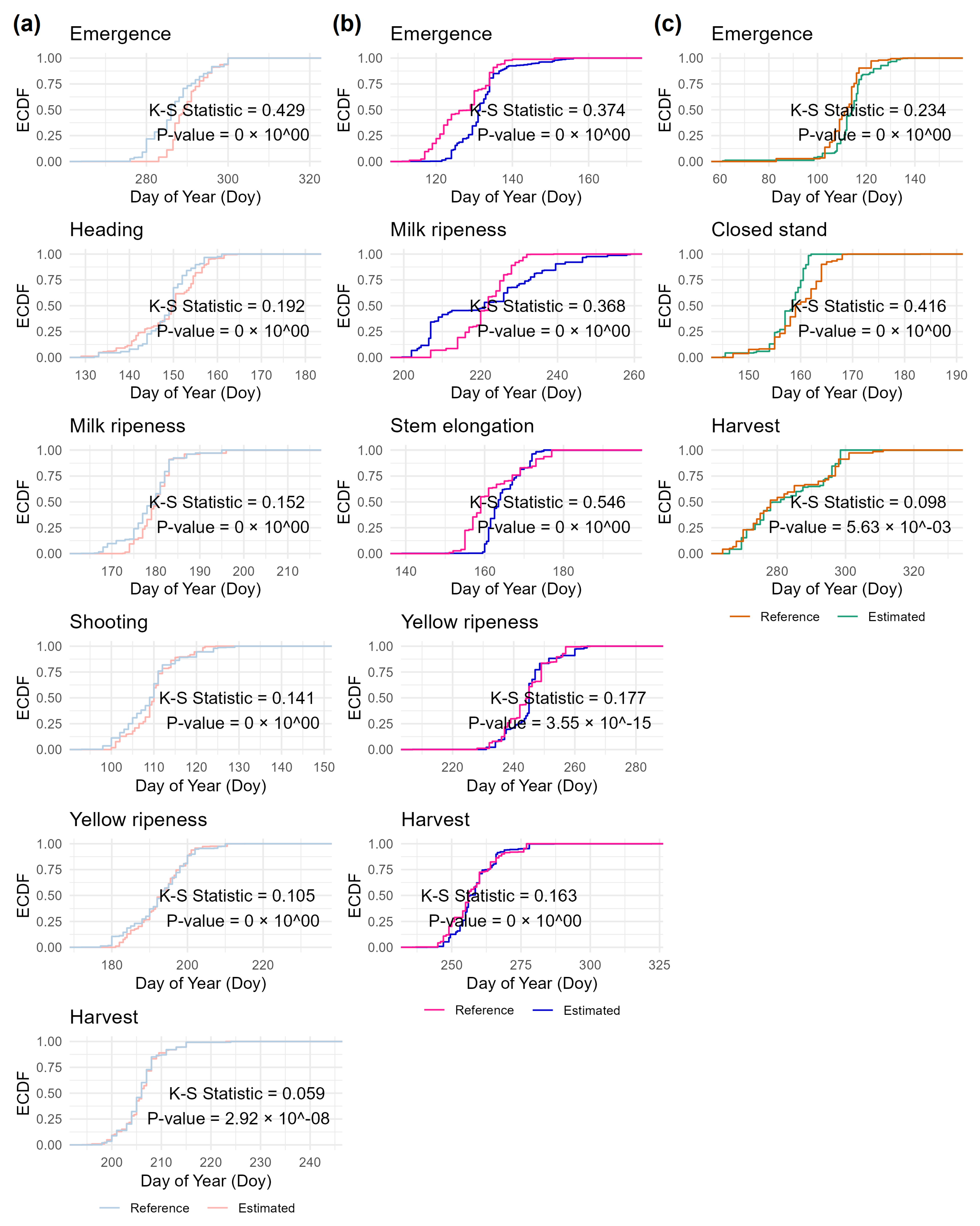


| Crop Type | BBCH Code | DWD Phase Description | DWD Phase ID | DWD Phase Distribution | N∘ of DWD Obs | N∘ of In-Situ BBCH Obs |
|---|---|---|---|---|---|---|
| Winter wheat | 10 | emergence | 12 | 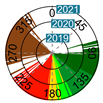 | 259 | 9 |
| 31 | shooting | 15 | 206 | 15 | ||
| 51 | heading | 18 | 264 | 2 | ||
| 75 | milk ripening | 19 | 216 | 17 | ||
| 87 | yellow ripening | 21 | 237 | 2 | ||
| 99 | harvest | 24 | 286 | 27 | ||
| Corn | 10 | emergence | 12 |  | 416 | 11 |
| 31 | stem elongation | 67 | 319 | 9 | ||
| 75 | milk ripening | 19 | 274 | 4 | ||
| 87 | yellow ripening | 21 | 227 | 2 | ||
| 99 | harvest | 24 | 332 | 6 | ||
| Sugar beet | 10 | emergence | 12 | 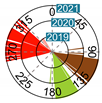 | 125 | 7 |
| 35 | closed stand | 13 | 120 | 6 | ||
| 99 | harvest | 24 | 93 | - |
Disclaimer/Publisher’s Note: The statements, opinions and data contained in all publications are solely those of the individual author(s) and contributor(s) and not of MDPI and/or the editor(s). MDPI and/or the editor(s) disclaim responsibility for any injury to people or property resulting from any ideas, methods, instructions or products referred to in the content. |
© 2024 by the authors. Licensee MDPI, Basel, Switzerland. This article is an open access article distributed under the terms and conditions of the Creative Commons Attribution (CC BY) license (https://creativecommons.org/licenses/by/4.0/).
Share and Cite
Htitiou, A.; Möller, M.; Riedel, T.; Beyer, F.; Gerighausen, H. Towards Optimising the Derivation of Phenological Phases of Different Crop Types over Germany Using Satellite Image Time Series. Remote Sens. 2024, 16, 3183. https://doi.org/10.3390/rs16173183
Htitiou A, Möller M, Riedel T, Beyer F, Gerighausen H. Towards Optimising the Derivation of Phenological Phases of Different Crop Types over Germany Using Satellite Image Time Series. Remote Sensing. 2024; 16(17):3183. https://doi.org/10.3390/rs16173183
Chicago/Turabian StyleHtitiou, Abdelaziz, Markus Möller, Tanja Riedel, Florian Beyer, and Heike Gerighausen. 2024. "Towards Optimising the Derivation of Phenological Phases of Different Crop Types over Germany Using Satellite Image Time Series" Remote Sensing 16, no. 17: 3183. https://doi.org/10.3390/rs16173183
APA StyleHtitiou, A., Möller, M., Riedel, T., Beyer, F., & Gerighausen, H. (2024). Towards Optimising the Derivation of Phenological Phases of Different Crop Types over Germany Using Satellite Image Time Series. Remote Sensing, 16(17), 3183. https://doi.org/10.3390/rs16173183









